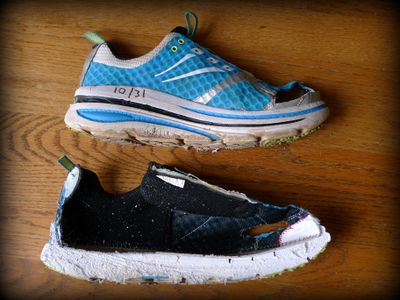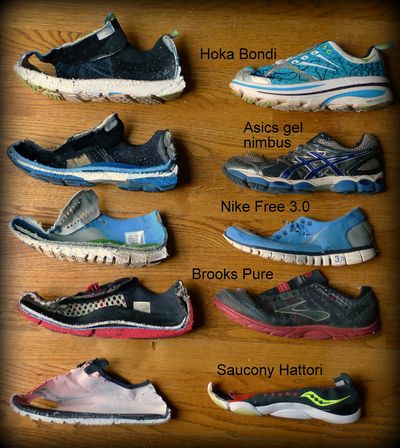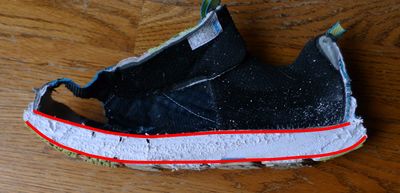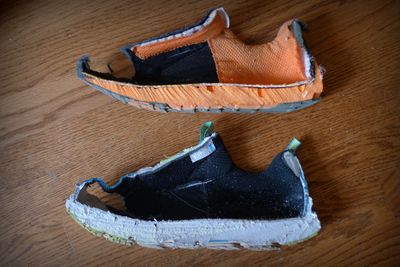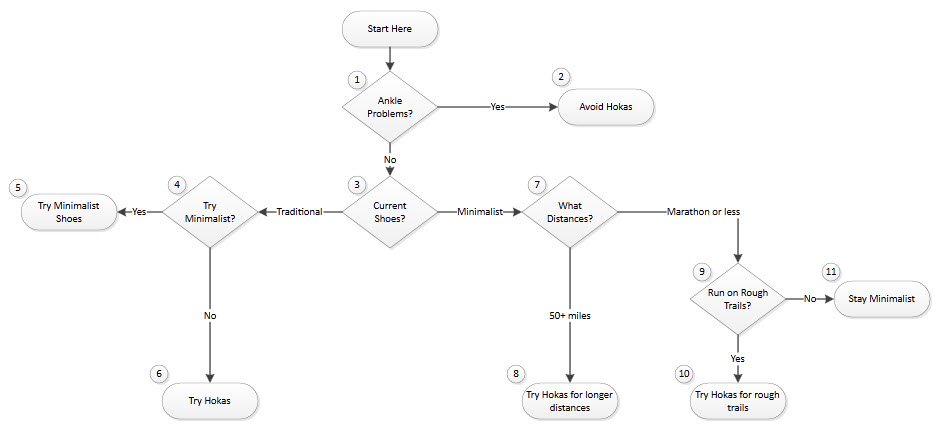A review and comparison of Hoka running shoes
The Hoka shoes started the 'maximum cushioning, minimum drop' style of shoe with their thick, softly cushioned soles. They reduce the pounding on the soles of your feet, but they are not without their downsides. The Hokas are one of my recommended running shoes, but I think the Altra Olympus/Altra Pardigm is a 'better Hoka'. However, highly cushioned shoes are not without their downsides and may be responsible for some running injuries. I've included some recommendations to help you evaluate if Hokas are right for you.
Contents
1 Introduction
Hoka One One, pronounced "Hoka O-nay O-nay", means "now it is time to fly" in Maori. These shoes have midsoles that are much thicker and softer than traditional shoes. The soles are also wider to prevent the higher soles making the shoes unstable, like stilts. However, the sole is not as thick as it appears from the outside, as you can see from the image below. The foam in the midsole comes up the sides of the shoe much higher.
2 The Hoka Advantages
- The Hokas provide remarkable protection for the soles of your feet. This protection is most noticeable on trails, where you can ignore far more of the stones and bumps. I've found this protection to be wonderful, as it has allowed me to run trails again, which would not otherwise be possible. Even on smoother surfaces, the Hokas can protect your soles, which is a factor over longer distances.
- The Hokas have far less of a drop between the heel and forefoot than a traditional shoe. The Hokas have claim 3-4.5mm of drop, but measurements suggest it's more like 6mm. Compared with a traditional running shoe like the Asics GT 2000 which has 9mm of drop, the Hokas seem quite flat. I've found that running in Hokas is a little like running barefoot on a padded track, which is quite impressive.
- The Hokas are remarkably light for their size, and other than the Mafete 2, they are comparable with a traditional running shoe. (Obviously they are heavier than a minimalist shoe.)
- The thick sole tapers from the forefoot to the front of the shoe, creating an effect that encourages a good forward lean and toe off. I've been surprised how much this has helped my biomechanics.
- There are many reports that the Hokas reduce Muscle fatigue, but I found no obvious difference in muscular soreness between the Hokas and the Modified Nike Free. Opinions of other runners going to Hokas from minimalist shoes varies, with some seeing a benefit and others not.
- While the Hokas are expensive ($170 in the US), but most runners find they last longer than a traditional running shoe, so the overall costs are lower. Of course, they don't last as long as some minimalist shoes; I get 2,000+ miles out of my Modified Nike Frees, but I only get I around 600 miles out of my Hokas.
3 The Hoka Problems
- The thick sole of the Hokas produces a greater ankle stress on uneven surfaces. The wider sole reduces this problem a little, but when trail running this is still an issue. In the past I have never had trouble with twisting my ankles, but the Hokas did cause some ankle stress and pain.
- The added cushioning protects the soles of the feet, but I've found I've had joint stress with the Hokas that I've never had with my Modified Nike Free. This is in line with the research that has shown greater joint stress with greater cushioning.
- Even though the cushioning of the Hokas is far softer than other shoes, the thickness makes them quite stiff. This reduces the natural flexing of the foot, but it also puts extra stress on some areas of your foot. The skin on the back of the heel has more friction and the tendons under where the laces are tied have more pressure. I've found that Lacing the Hokas loosely limits the tendon stress, and my favored sock combination mitigates the friction.
- I've found my Running Form tends to degrade while running in the Hokas rather than my Modified Nike Free. When I swap back, it takes a few miles for my form to recover. I've also noticed that my Cadence is lower in the Hokas, but this might be due to the extra weight.
- The toe box of the Hokas is rather tight for many people which causes blisters (see below).
- I didn't like the speed Lacing system that comes with the Hokas, but it's easy to replace them with traditional laces. Hoka includes alternative laces, but I found they were too slippery to stay knotted.
4 Hoka Blisters
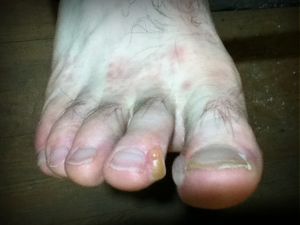
I've seen a distinctive pattern of blisters associated with the Hokas, where the blister forms part way along the toes, normally between the big toe and the next toe along, and sometimes between the little toe and its neighbor. I saw a disproportionate number of Hoka wearing runners with this blister pattern at the Umstead 100. This can be avoided by cutting open the toe box, but far too few people do this.
5 Recommendations
My recommendation depends on what type of runner you are.
The numbers in the decision chart above correspond to the notes below:
- Do you suffer from twisted or weak ankles? Hokas are likely to make this problem worse.
- Avoid Hokas, but consider minimalist shoes
- Are your current shoes traditional or minimalist?
- Are you willing to try out minimalist shoes? I'm a big proponent of minimalist footwear, but I realize not everyone wants to try it out.
- See how one of these minimalist shoes works for you.
- Try the Hokas, starting with the Bondi Speed or the Bondi B
- How far do you run? Hokas may have some advantages over minimalist shoes for longer ultramarathons.
- Try the Hokas for your longer runs. Obviously test them out on shorter runs and build up, but I'd recommend using the Hokas for the long stuff and the minimalist shoes for the rest.
- Do you run on rough trails, where your feet may get sore from stone bruises?
- Try one of the trail Hokas, like the Stinson Evo or even the Mafate 2 if you want more protection.
- You're probably best staying with the minimalist footwear, though it may be worth trying out a pair of Hokas.
I'd suggest getting your shoes from somewhere with free shipping both ways, like Zappos, who also have one of the best selections of Hoka shoes I've found. (While Road Runner Sports has the advantage of letting you run in shoes and still return them for an exchange, they don't stock Hokas.)
6 Comparison of the Shoes in the Hoka Range
To put the Hoka range into a wider context, see the review of the best running shoes.
- Hoka Bondi. Of all the Hoka shoes I've tried, the various Bondi shoes (Bondi B, Bondi 2, Bondi 3 and Bondi Speed) are my favorites. Like all Hokas, the Bondi has a horribly small toe box, it's easily modified.
- Hoka Stinson. The Stinson is a little heavier and thicker than the Bondi variants, and is available in road and trail versions.
- Hoka Mafate. The Mafate is a huge shoe, and the heaviest and thickest of the Hokas.
- Hoka Conquest. While this is as big and heavy as a Hoka Bondi, the overly firm foam rulings the shoe.
- Hoka Rapa Nui. The Rapa Nui 2 is lighter, thinner and a little cheaper than the other Hokas, but I found it even firmer than the Conquest. In fact, the Adidas Energy Boost feels far more cushioned to me, though it does not offer the same level of protection from stones or uneven surfaces.
